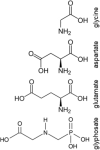Yeast of Eden: microbial resistance to glyphosate from a yeast perspective
- PMID: 37269314
- PMCID: PMC10716058
- DOI: 10.1007/s00294-023-01272-4
Yeast of Eden: microbial resistance to glyphosate from a yeast perspective
Abstract
First marketed as RoundUp, glyphosate is history's most popular herbicide because of its low acute toxicity to metazoans and broad-spectrum effectiveness across plant species. The development of glyphosate-resistant crops has led to increased glyphosate use and consequences from the use of glyphosate-based herbicides (GBH). Glyphosate has entered the food supply, spurred glyphosate-resistant weeds, and exposed non-target organisms to glyphosate. Glyphosate targets EPSPS/AroA/Aro1 (orthologs across plants, bacteria, and fungi), the rate-limiting step in the production of aromatic amino acids from the shikimate pathway. Metazoans lacking this pathway are spared from acute toxicity and acquire their aromatic amino acids from their diet. However, glyphosate resistance is increasing in non-target organisms. Mutations and natural genetic variation discovered in Saccharomyces cerevisiae illustrate similar types of glyphosate resistance mechanisms in fungi, plants, and bacteria, in addition to known resistance mechanisms such as mutations in Aro1 that block glyphosate binding (target-site resistance (TSR)) and mutations in efflux drug transporters non-target-site resistance (NTSR). Recently, genetic variation and mutations in an amino transporter affecting glyphosate resistance have uncovered potential off-target effects of glyphosate in fungi and bacteria. While glyphosate is a glycine analog, it is transported into cells using an aspartic/glutamic acid (D/E) transporter. The size, shape, and charge distribution of glyphosate closely resembles D/E, and, therefore, glyphosate is a D/E amino acid mimic. The mitochondria use D/E in several pathways and mRNA-encoding mitochondrial proteins are differentially expressed during glyphosate exposure. Mutants downstream of Aro1 are not only sensitive to glyphosate but also a broad range of other chemicals that cannot be rescued by exogenous supplementation of aromatic amino acids. Glyphosate also decreases the pH when unbuffered and many studies do not consider the differences in pH that affect toxicity and resistance mechanisms.
Keywords: Amino acid mimic; Aro1; Dip5; EPSPS; Genetic variation; Glyphosate; Herbicide; In-lab evolutions; Microbial resistance; Non-target-site resistance; Target-site resistance.
© 2023. The Author(s).
Conflict of interest statement
The authors have not disclosed any competing interests.
Figures



Similar articles
-
Genetic variation in Dip5, an amino acid permease, and Pdr5, a multiple drug transporter, regulates glyphosate resistance in S. cerevisiae.PLoS One. 2017 Nov 20;12(11):e0187522. doi: 10.1371/journal.pone.0187522. eCollection 2017. PLoS One. 2017. PMID: 29155836 Free PMC article.
-
A Glyphosate-Based Herbicide Cross-Selects for Antibiotic Resistance Genes in Bacterioplankton Communities.mSystems. 2022 Apr 26;7(2):e0148221. doi: 10.1128/msystems.01482-21. Epub 2022 Mar 10. mSystems. 2022. PMID: 35266795 Free PMC article.
-
Protein identification before and after glyphosate exposure in Lolium multiflorum genotypes.Pest Manag Sci. 2018 May;74(5):1125-1133. doi: 10.1002/ps.4831. Epub 2018 Feb 16. Pest Manag Sci. 2018. PMID: 29250898
-
Molecular mechanisms underlying glyphosate resistance in bacteria.Environ Microbiol. 2021 Jun;23(6):2891-2905. doi: 10.1111/1462-2920.15534. Epub 2021 Jun 2. Environ Microbiol. 2021. PMID: 33876549 Review.
-
Glyphosate resistance: state of knowledge.Pest Manag Sci. 2014 Sep;70(9):1367-77. doi: 10.1002/ps.3743. Pest Manag Sci. 2014. PMID: 25180399 Free PMC article. Review.
Cited by
-
Agar lot-specific inhibition in the plating efficiency of yeast spores and cells.G3 (Bethesda). 2024 Sep 23;14(12):jkae229. doi: 10.1093/g3journal/jkae229. Online ahead of print. G3 (Bethesda). 2024. PMID: 39312221 Free PMC article.
References
-
- Barney JB, Winans MJ, Blackwood CB, et al. The yeast atlas of appalachia: species and phenotypic diversity of herbicide resistance in wild yeast. Diversity. 2020;12:139. doi: 10.3390/d12040139. - DOI
Publication types
MeSH terms
Substances
Grants and funding
LinkOut - more resources
Full Text Sources
Molecular Biology Databases
Miscellaneous

